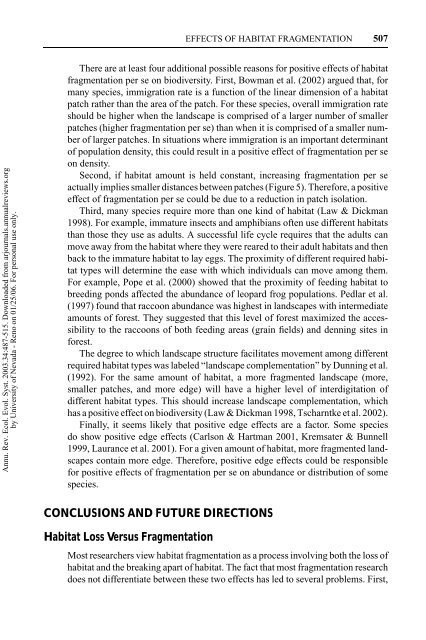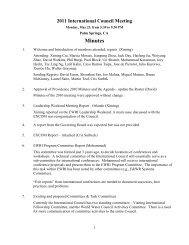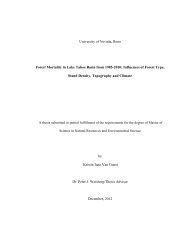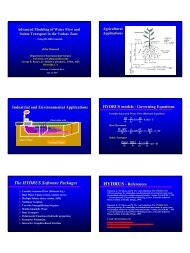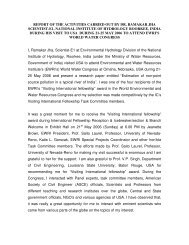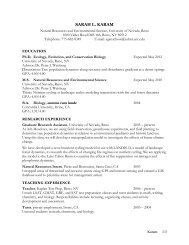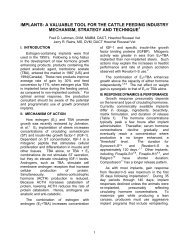Fahrig, L. 2003. Effects of habitat fragmentation on biodiversity ...
Fahrig, L. 2003. Effects of habitat fragmentation on biodiversity ...
Fahrig, L. 2003. Effects of habitat fragmentation on biodiversity ...
Create successful ePaper yourself
Turn your PDF publications into a flip-book with our unique Google optimized e-Paper software.
EFFECTS OF HABITAT FRAGMENTATION 507Annu. Rev. Ecol. Evol. Syst. <str<strong>on</strong>g>2003.</str<strong>on</strong>g>34:487-515. Downloaded from arjournals.annualreviews.orgby University <str<strong>on</strong>g>of</str<strong>on</strong>g> Nevada - Reno <strong>on</strong> 01/25/06. For pers<strong>on</strong>al use <strong>on</strong>ly.There are at least four additi<strong>on</strong>al possible reas<strong>on</strong>s for positive effects <str<strong>on</strong>g>of</str<strong>on</strong>g> <str<strong>on</strong>g>habitat</str<strong>on</strong>g><str<strong>on</strong>g>fragmentati<strong>on</strong></str<strong>on</strong>g> per se <strong>on</strong> <strong>biodiversity</strong>. First, Bowman et al. (2002) argued that, formany species, immigrati<strong>on</strong> rate is a functi<strong>on</strong> <str<strong>on</strong>g>of</str<strong>on</strong>g> the linear dimensi<strong>on</strong> <str<strong>on</strong>g>of</str<strong>on</strong>g> a <str<strong>on</strong>g>habitat</str<strong>on</strong>g>patch rather than the area <str<strong>on</strong>g>of</str<strong>on</strong>g> the patch. For these species, overall immigrati<strong>on</strong> rateshould be higher when the landscape is comprised <str<strong>on</strong>g>of</str<strong>on</strong>g> a larger number <str<strong>on</strong>g>of</str<strong>on</strong>g> smallerpatches (higher <str<strong>on</strong>g>fragmentati<strong>on</strong></str<strong>on</strong>g> per se) than when it is comprised <str<strong>on</strong>g>of</str<strong>on</strong>g> a smaller number<str<strong>on</strong>g>of</str<strong>on</strong>g> larger patches. In situati<strong>on</strong>s where immigrati<strong>on</strong> is an important determinant<str<strong>on</strong>g>of</str<strong>on</strong>g> populati<strong>on</strong> density, this could result in a positive effect <str<strong>on</strong>g>of</str<strong>on</strong>g> <str<strong>on</strong>g>fragmentati<strong>on</strong></str<strong>on</strong>g> per se<strong>on</strong> density.Sec<strong>on</strong>d, if <str<strong>on</strong>g>habitat</str<strong>on</strong>g> amount is held c<strong>on</strong>stant, increasing <str<strong>on</strong>g>fragmentati<strong>on</strong></str<strong>on</strong>g> per seactually implies smaller distances between patches (Figure 5). Therefore, a positiveeffect <str<strong>on</strong>g>of</str<strong>on</strong>g> <str<strong>on</strong>g>fragmentati<strong>on</strong></str<strong>on</strong>g> per se could be due to a reducti<strong>on</strong> in patch isolati<strong>on</strong>.Third, many species require more than <strong>on</strong>e kind <str<strong>on</strong>g>of</str<strong>on</strong>g> <str<strong>on</strong>g>habitat</str<strong>on</strong>g> (Law & Dickman1998). For example, immature insects and amphibians <str<strong>on</strong>g>of</str<strong>on</strong>g>ten use different <str<strong>on</strong>g>habitat</str<strong>on</strong>g>sthan those they use as adults. A successful life cycle requires that the adults canmove away from the <str<strong>on</strong>g>habitat</str<strong>on</strong>g> where they were reared to their adult <str<strong>on</strong>g>habitat</str<strong>on</strong>g>s and thenback to the immature <str<strong>on</strong>g>habitat</str<strong>on</strong>g> to lay eggs. The proximity <str<strong>on</strong>g>of</str<strong>on</strong>g> different required <str<strong>on</strong>g>habitat</str<strong>on</strong>g>types will determine the ease with which individuals can move am<strong>on</strong>g them.For example, Pope et al. (2000) showed that the proximity <str<strong>on</strong>g>of</str<strong>on</strong>g> feeding <str<strong>on</strong>g>habitat</str<strong>on</strong>g> tobreeding p<strong>on</strong>ds affected the abundance <str<strong>on</strong>g>of</str<strong>on</strong>g> leopard frog populati<strong>on</strong>s. Pedlar et al.(1997) found that racco<strong>on</strong> abundance was highest in landscapes with intermediateamounts <str<strong>on</strong>g>of</str<strong>on</strong>g> forest. They suggested that this level <str<strong>on</strong>g>of</str<strong>on</strong>g> forest maximized the accessibilityto the racco<strong>on</strong>s <str<strong>on</strong>g>of</str<strong>on</strong>g> both feeding areas (grain fields) and denning sites inforest.The degree to which landscape structure facilitates movement am<strong>on</strong>g differentrequired <str<strong>on</strong>g>habitat</str<strong>on</strong>g> types was labeled “landscape complementati<strong>on</strong>” by Dunning et al.(1992). For the same amount <str<strong>on</strong>g>of</str<strong>on</strong>g> <str<strong>on</strong>g>habitat</str<strong>on</strong>g>, a more fragmented landscape (more,smaller patches, and more edge) will have a higher level <str<strong>on</strong>g>of</str<strong>on</strong>g> interdigitati<strong>on</strong> <str<strong>on</strong>g>of</str<strong>on</strong>g>different <str<strong>on</strong>g>habitat</str<strong>on</strong>g> types. This should increase landscape complementati<strong>on</strong>, whichhas a positive effect <strong>on</strong> <strong>biodiversity</strong> (Law & Dickman 1998, Tscharntke et al. 2002).Finally, it seems likely that positive edge effects are a factor. Some speciesdo show positive edge effects (Carls<strong>on</strong> & Hartman 2001, Kremsater & Bunnell1999, Laurance et al. 2001). For a given amount <str<strong>on</strong>g>of</str<strong>on</strong>g> <str<strong>on</strong>g>habitat</str<strong>on</strong>g>, more fragmented landscapesc<strong>on</strong>tain more edge. Therefore, positive edge effects could be resp<strong>on</strong>siblefor positive effects <str<strong>on</strong>g>of</str<strong>on</strong>g> <str<strong>on</strong>g>fragmentati<strong>on</strong></str<strong>on</strong>g> per se <strong>on</strong> abundance or distributi<strong>on</strong> <str<strong>on</strong>g>of</str<strong>on</strong>g> somespecies.CONCLUSIONS AND FUTURE DIRECTIONSHabitat Loss Versus Fragmentati<strong>on</strong>Most researchers view <str<strong>on</strong>g>habitat</str<strong>on</strong>g> <str<strong>on</strong>g>fragmentati<strong>on</strong></str<strong>on</strong>g> as a process involving both the loss <str<strong>on</strong>g>of</str<strong>on</strong>g><str<strong>on</strong>g>habitat</str<strong>on</strong>g> and the breaking apart <str<strong>on</strong>g>of</str<strong>on</strong>g> <str<strong>on</strong>g>habitat</str<strong>on</strong>g>. The fact that most <str<strong>on</strong>g>fragmentati<strong>on</strong></str<strong>on</strong>g> researchdoes not differentiate between these two effects has led to several problems. First,


